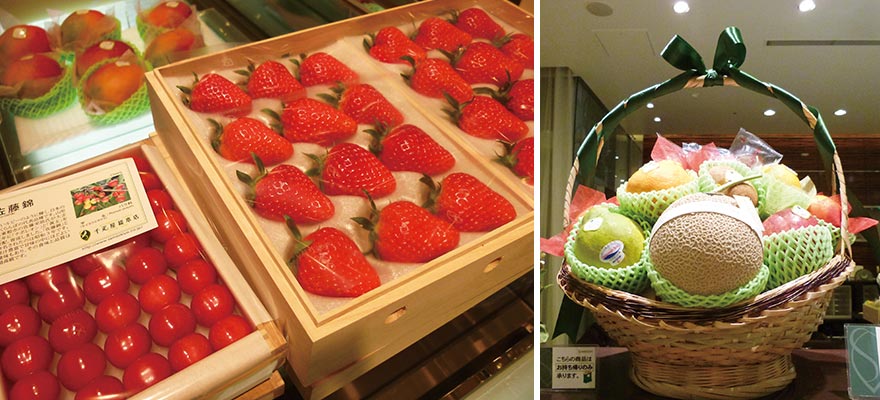Home > Highlighting JAPAN >Highlighting Japan April 2014>Washoku
Highlighting JAPAN
Washoku
Edible Diamonds
Japanese fruit beloved around the world

It would be no exaggeration to say that the delicious flavor of Japanese fruit comes as a shock to many people from other countries. Not only does Japanese fruit look good, it's sweet, fragrant, juicy and each piece is full of personality.
The high price tag also comes as a surprise to many foreigners. It's even said that eating Japanese fruit is considered a symbol of affluence in some countries.
In the large cities of Asia, where economic and industrial development have led to rapid growth in prosperity, Japanese fruit can be purchased at many major supermarkets and Japan-related shops. Though still priced as a luxury item when considered in light of typical household income, Japanese fruit is being enjoyed abroad by more and more people every year, with a corresponding increase in both reputation and sales. A simple piece of fruit may not technically count as Japanese cuisine in the same way as tempura or sukiyaki, but there's no question that Japanese fruit possesses a level of quality all its own.
"There has definitely been an increase in the number of customers from other countries buying fruit at our store," says Ushio Oshima of Sembikiya-Sohonten, Ltd., a leading and long-established seller of high-grade Japanese fruit. "The number of customers from Asian countries is especially large."
A wide variety of fruit comes into season over the course of Japan's four varied seasons each year. Many of these fruits, like apples, grapes, strawberries and melons, are common in other countries as well – but when it comes to flavor and aroma, customers say Japanese fruit is on a completely different level.
"When you try to produce a sweeter fruit, you have to thin out more of the crop to raise the sugar content, which means there will be less fruit on the market," Oshima explains. "If you do that, the price will naturally rise." Fruit was once a high-class item in Japan as well, and aside from mandarin oranges and Japanese persimmons, which had long been common food, the majority of it was restricted to the wealthy few who could afford to eat it. Average people only started eating the more high-end fruit on a day-to-day basis after World War II, and even then many fruits remained on the semi–luxury level for some time. The Japanese cultural tradition of giving fruit as a gift is largely a result of these historical circumstances. "Since they're gifts, they have to taste good," Oshima explains. "This is how Japanese people see it, and that may have ended up boosting the Japanese standard for fruit."
"In an environment where you can grow large quantities of fruit on huge expanses of land, it's generally best to sell a lot of produce at low prices, and in such a situation people probably won't have very high expectations with regard to flavor or aroma. If you're growing fruit on a limited amount of land as is the case in Japan, however, your harvest will naturally be limited. But because you have less space, you can also take more care to improve quality. Selling high-quality, high-value produce, grown over time and with great effort even in small quantities, was the only way for Japanese farmers to increase their profits. Of course, Japanese people's natural tendency to pursue tasks with diligence – along with the rather refined tastes of the average Japanese person – are also reasons why Japanese fruit has become so delicious."
Japan's fruits have even been called 'edible diamonds' by buyers from abroad. Indeed, it may be precisely because fruit is available everywhere that the luxurious flavors achieved through careful application of Japanese techniques has led the nation's fruit to be loved all over the world.
© 2009 Cabinet Office, Government of Japan






